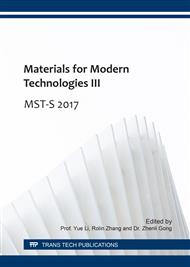[1]
LI Jie, ZHANG Gang, LAI Yan-qing, ZHANG Yong and TIAN Zhong-liang. Densification and sintering dynamics of 10NiO-NiFe2O4 composites doped with CaO. Journal of Central South University of Technology, 14(2007), 5, p.629−632.
DOI: 10.1007/s11771-007-0120-2
Google Scholar
[2]
R. P. Pawlek, in: Inert Anodes: An Update, [in]A. Tabereaux, eds., Light Metals 2004, TMS, Warrendale, 2004, p.283–287.
Google Scholar
[3]
R. P. Pawlek, in: Inert Anodes: An Update, [in] D. H. DeYoung, eds., Light Metals 2008, TMS, Warrendale, 2008, p.1039–1045.
Google Scholar
[4]
K. C. Zhou and Y. Q. Tao, Research Development of Nickel Ferrite Based Cermet Inert Anode Materials, Chin. J. Nonferr. Met., 21 (2011), p.2418–2429.
Google Scholar
[5]
T. R. Alcorn, A. T. Tabereaux, N. E. Richards, C. F. Windisch, D. M. Strachan, J. S. Gregg, and M. S. Frederick, in: Operational Results of Pilot Cell Test with Cermet Inert, Anodes, [in] M. B. Christian, eds., Light Metals 1993, TMS, Warrendale, 1993, p.433.
DOI: 10.2172/6231844
Google Scholar
[6]
Z. L. Tian, Y. Q. Lai, Z. Y. Li, J. Li, K. C. Zhou and Y. X. Liu, Cup-Shaped Functionally Gradient NiFe2O4-based Cermet Inert Anodes for Aluminum Reduction, JOM, 61 (2009) , p.34–38.
DOI: 10.1007/s11837-009-0067-x
Google Scholar
[7]
Kechao ZHOU, Zhiyou LI, Lei ZHANG.The Cermet Inert Anode Materials for Aluminum Electrolysis. Changsha: the Press of Central South University,2012, pp.51-67.
Google Scholar
[8]
Lorentsen, O. A, Thonstad.J. in: Electrolysis and Post-testing of Inert Cermet Anodes, [in] Wolfgang, S. , eds., Light Metals 2002, TMS, Warrendale, 2002, pp.443-449.
Google Scholar
[9]
Olsen. E, Thonstad, J. Nickel Ferrite as Inert Anodes in Aluminum Electrolysis: Part II Material Performance and Long-Term Testing. Journal of Applied Electrochemistry, 29 (1999) , pp.301-311.
Google Scholar
[10]
Liu, Jianyuan, Li, Zhiyou, Tao, Yuqiang, Zhang, Dou and Zhou, Kechao, Phase Evolution of 17(Cu-10Ni)-(NiFe2O4-10NiO) Cermet Inert Anode during Aluminum Electrolysis, Transactions of Nonferrous Metals Society of China, 21 (2011), pp.566-572.
DOI: 10.1016/s1003-6326(11)60752-8
Google Scholar
[11]
Liu, Baogang, Zhang, Lei, Zhou, Kechao, Li, Zhiyou and Wang, Hao. Electrical conductivity and molten salt corrosion behavior of spinel nickel ferrite, Solid State Sciences, 13(2011), pp.1483-1487.
DOI: 10.1016/j.solidstatesciences.2011.05.004
Google Scholar
[12]
Hanbing HE, Yuan WANG, Jiaju LONG, Zhaohui CHEN. Corrosion of NiFe2O4-10NiO based cermet inert anode for aluminium electrolysis, Transactions of Nonferrous Metals Society of China, 23 (2013), 12, pp.3816-3821.
DOI: 10.1016/s1003-6326(13)62934-9
Google Scholar
[13]
H. He. The formation law of dense NiFe2O4-NiAl2O4-FeAl2O4 ceramic layer on the surface of NiFe2O4 based ceramic inert anode for aluminium electrolysis, Materials Research Innovations, 18 (2014), 2, pp.138-141.
DOI: 10.1179/1432891714z.000000000403
Google Scholar
[14]
Hanbing HE. Behaviour and Material Properties of the Grain Boundary on the Surface of an Anode during the Formation of a Dense Layer, Applied Mechanics and Materials, 508 (2014) pp.61-65.
DOI: 10.4028/www.scientific.net/amm.508.61
Google Scholar
[15]
Hanbing HE, Zhaohui CHEN. Corrosion behavior of NiFe2O4-10NiO based cermet inert anode surface for aluminum electrolysis, METALURGIA INTERNATIONAL, 18(2013), 10, pp.58-60.
Google Scholar
[16]
ZHANG Songbin, ZHAO Qun. Study on the Electrical Conductivity of Nickel Aluminate Spinel Used as Inert Anode in Aluminum Electrolysis Cell. Modern Technical Ceramics, 24(2003), 2, p.7–9.
Google Scholar
[17]
TIAN Zhongliang, LAI Yanqing, LI Jie and LIU Yexiang.Electrical Conductivities of NiFe2O4 Based Ceramics. Materials Science and Engineering of Powder Metallurgy, 10(2005), 2, pp.110-115.
Google Scholar
[18]
HE Hanbing, XIAO Hanning, ZHOU Kechao. Effect of additive BaO on corrosion resistance of xCu/(10NiO-NiFe2O4) cermet inert anodes for aluminum electrolysis, Transactions of Nonferrous Metals Society of China, 21(2011), pp.102-108.
DOI: 10.1016/s1003-6326(11)60684-5
Google Scholar
[19]
He Hanbing, Zhou Kechao, Li Zhiyou and Huang, Baiyun, Effect of BaO Addition on Electric Conductivity of xCu/NiFe2O4-10NiO Cermets. Transactions of Nonferrous Metals Society of China, 18(2008), 5, p.1134–1138.
DOI: 10.1016/s1003-6326(08)60194-6
Google Scholar


